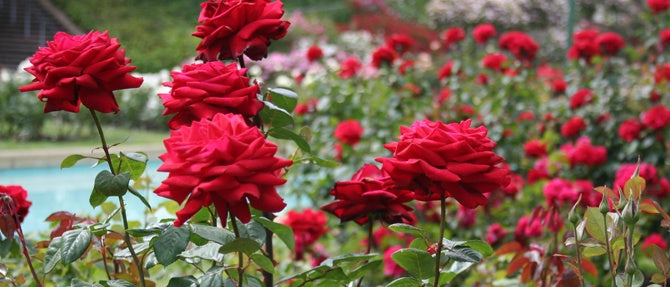The rose provides long lasting beautiful spring and summer colour. Many beginner gardeners may be put off by roses as they can seem like hard work, something that’s left to the garden guru or the long term gardener. This is not at all true and we’re here to help. Every garden deserves a rose or two.
First of all, what are all the types of roses you may see in the garden centres? It’s enough to scare anyone away. So we just want to simplify it for you all and hopefully get you into rose gardening.
There are four main types of roses:
Hybrid Tea
Hybrid tea roses offer a single rose at the end of a long stem, meaning that they are absolutely perfect to cut and have them displayed in a vase in flower arrangements. They are normally a larger rose and quite showy, some may be perfumed.
The structure of the hybrid tea rose is tall and upright and they grow better in the ground than in containers.
Floribunda
Floribunda roses appear in clusters on each branch and are usually a smaller flower. They offer long periods of flowering. They are usually more compact in growth habit.
Floribunda roses are more suited to pots than the hybrid tea. They can be used to create uniform rows as they can all be pruned to the same height each year. They are a slightly easier rose to care for than the hybrid tea and look good in large groupings.
Standard Roses
Standard roses are roses that have been standardised, meaning that they are grafted onto a single stem. This stem can come in various sizes from the ground. These roses are good to create features in the garden, they can be put into large pots and also look good planted in a row, down a path or driveway.
Standard roses do look amazing in groups of three and I am a big fan of the look they create.
Climbing Roses
Well the name pretty much says it on this one, but yes they are a rose that climbs. They can be trained up any structure such as a fence or pergola. They put on a magnificent show and can look quite effective when entertaining guests.
What does bare root mean?
 If you have seen bare root roses for sale, and are a little confused as to what it means, it simply means that the roses are sold without being in the soil. They are harvested when they are in a dormant state so as to not disturb the plant, and can then be easily transplanted directly into your garden.
If you have seen bare root roses for sale, and are a little confused as to what it means, it simply means that the roses are sold without being in the soil. They are harvested when they are in a dormant state so as to not disturb the plant, and can then be easily transplanted directly into your garden.
This can be a more cost-effective way to buy your rose as you are not paying for the soil and pot and it can be easier as well. I would just suggest that after purchasing your bare root rose that you get it into the ground as soon as possible so it can start beginning to form a nice root structure in its new home. Do not let the root system dry out during transport.
We advise that you soak your bare-rooted roses in a bucket of water mixed with a seaweed-based liquid fertiliser for at least an hour before planting.
Tips for planting your rose
- Full sun is best, aim for around 6 hours plus of sunlight a day
- Roses are heavy feeders. Put some sheep pellets or poultry compost at the bottom of the hole before planting.
- Adding compost and organic matter to the soil is very beneficial. Alternatively, try adding a product called Novatec which is a slow-release fertiliser that you can also use in pots.
- Rose fertiliser is formulated just for roses but be careful of use in pots.
- Dig the hole twice as wide and deep as the pot.
- Ensure any graft is above soil level.
- Good drainage is essential.
- Water in well and continue to water often throughout the warmer months.
- Do not plant roses too close to one another as they need good airflow to inhibit fungal diseases.
- Deadhead spent flowers to improve its appearance throughout the growing season.
Throughout the growing season be careful to watch out for insect and fungal problems. Conqueror oil can be used to smother the plants with a protective oil and get rid of any insects such as aphids. Copper Spray is used to treat any fungal problems such as mildew. Yates Rose Gun is also very good at managing pests and diseases.
Happy rose gardening!



























